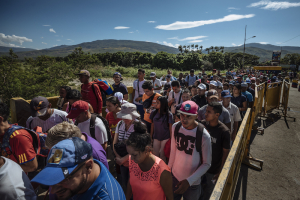Indikatoren in dieser Dimension analysieren, inwieweit Migrantinnen und Migranten hinsichtlich des Zugangs zu grundlegenden sozialen Diensten wie Gesundheit, Bildung und soziale Sicherheit den gleichen Status wie Bürgerinnen und Bürger haben. Es beschreibt die Rechte von Migrantinnen und Migranten auf Familienzusammenführung, Arbeit, Aufenthalt und Staatsbürgerschaft. Die Ratifizierung der wichtigsten internationalen Konventionen fällt ebenfalls in diesen Bereich.main.
Indikatoren in dieser Dimension bewerten die institutionellen, rechtlichen und regulatorischen Rahmenbedingungen der Länder im Zusammenhang mit Migrationspolitik. Dimension 2 beinhaltet auch das Vorhandensein von nationalen Migrationsstrategien, die mit Entwicklungspolitik und -ansätzen im Einklang stehen, sowie die institutionelle Transparenz und Kohärenz in Bezug auf Migrationsmanagement. In diesem Bereich wird auch untersucht, inwieweit Regierungen Migrationsdaten erheben und verwenden.
Diese Dimension konzentriert sich auf die Bemühungen von Ländern, in migrationsbezogenen Fragen mit anderen Staaten und einschlägigen nichstaatlichen Akteuren, einschließlich Organisationen der Zivilgesellschaft und des Privatsektors, zusammenzuarbeiten. Kooperation kann zu Verbesserungen der Regierungsführung führen, indem Standards angeglichen und angehoben, der Dialog intensiviert und Strukturen der Bewältigung von Herausforderungen geschaffen werden.
Diese Dimension umfasst Indikatoren für die Politik der Länder zur Steuerung des sozioökonomischen Wohlergehens von Migrantinnen und Migranten, z.B. die Anerkennung der Bildungs- und Berufsqualifikationen von Migrantinnen und Migranten, Bestimmungen zur Regelung der Studentenmigration und das Bestehen bilateraler Arbeitsabkommen zwischen Ländern. Die Indikatoren konzentrieren sich gleichermaßen auf Maßnahmen und Strategien im Zusammenhang mit dem Engagement der Diasporamitglieder und den grenzüberschreitenden Geldtransfers von Migrantinnen und Migranten
Diese Dimension befasst sich mit der Art und dem Grad der Bereitschaft von Ländern, wenn sie mit Mobilitätsdimensionen von Krisen konfrontiert sind, die entweder mit Katastrophen, der Umwelt und/oder Konflikten zusammenhängen. Die Fragen werden verwendet, um die Prozesse für Staatsangehörige und Ausländer sowohl während als auch Katastrophen zu ermitteln, einschließlich der Frage, ob humanitäre Hilfe für Migrantinnen und Migranten genauso verfügbar ist wir für Bürgerinnen und Bürger.
Diese Dimension analysiert den Ansatz der Länder zum Migrationsmanagement bezüglich Grenzkontroll- und Grenzschutzmaßnahmen, Zulassungsvoraussetzungen für Migranten, Vorbereitung und Flexibilität bei erheblichen und unerwarteten Wanderungsbewegungen sowie die Bekämpfung des Menschenhandels und des Menschenschmuggels von Migrantinnen und Migranten. Es werden auch die Bemühungen und Anreize zur Unterstützung der Integration der zurückkehrenden Staatsbürgerinnen und -burger bewertet.
This country Profile describes examples of well-developed areas of the Republic of Suriname (hereafter referred to as Suriname) migration governance structures and areas with potential for further development, as evaluated through the six domains of the Migration Governance Indicators (MGI). These address migrants’ rights, a “whole-of-government” approach, partnerships, socioeconomic well-being of migrants, the mobility dimensions of crises, and safe and orderly migration.
Click the icons on the wheel to explore the key findings.
The Migration Governance Indicators (MGI) initiative is a policy-benchmarking programme led by the International Organization for Migration (IOM) and implemented with research and analysis from the Economist Intelligence Unit. Funding is provided by IOM Member States.
Migration Governance: examples of well-developed areas
- Migrants, irrespective of migratory status, have access to government-funded emergency medical treatment.
- The Personnel Act (1962) and the Family Employment Protection Act (2019) state that labour-related benefits – such as maternity leave and invalidity benefits – are provided to all employees regardless of nationality.
- Migrants can access government-funded primary and secondary education as well as vocational training on the same basis as citizens of Suriname.
- All temporary foreign residents can apply for a permanent residence permit after legally residing in Suriname for at least five years.
Areas with potential for further development
- Only certain categories of migrants have equal access to employment as nationals.
- Citizens of Suriname who are abroad cannot vote in national elections.
- There is no specific policy or strategy to combat hate crimes, violence, xenophobia and discrimination against migrants.
Migration Governance: examples of well-developed areas
- The 2022–2026 Multi-Year Development Plan (2021) take migrations issues into consideration.
- The Ministry of Foreign Affairs, International Business and International Cooperation collaborates with the private sector for its e-visa platform. The General Bureau of Statistics collects and publishes migration data on a regular basis.
- Suriname’s latest census, conducted in 2012 by the General Bureau of Statistics, contained a dedicated section on international and domestic migration.
Areas with potential for further development
- There is no overall coordination mechanism on migration issues.
- Suriname does not have an active inter-ministerial coordination mechanism on migration issues.
- The majority of rules and regulations pertaining to migration are presented mostly in Dutch language.
Migration Governance: examples of well-developed areas
- Suriname participates in the South American Conference on Migration as well as the Caribbean Migration Consultations and is a member of the Caribbean Community (CARICOM).
- The country is a signatory of the Revised Treaty of Chaguaramas establishing the CARICOM Caribbean Single Market and Economy (CSME), which allows labour mobility between member states.
- In 2008, Suriname’s Ministry of Foreign Affairs, International Business and International Cooperation signed a memorandum of understanding on readmission with the Ministry of Justice of the Netherlands.
- Suriname engages civil society organizations in migration policy development.
Areas with potential for further development
- Suriname engages members of diaspora and expatriate communities in national development policy on an ad hoc basis.
- The country engages the private sector in migration-related policy development on an ad hoc basis.
Migration Governance: examples of well-developed areas
- The Department of Labour Statistics has a working group together with the General Bureau of Statistics to monitor labour market demand for immigrants.
- The General Bureau of Statistics collects labour market data disaggregated by migration status and sex through its annual household surveys.
- Suriname accounts for migrant workers' skills and capabilities when deciding whether to admit them.
- The country has accreditation procedures and formalized criteria for recognizing international qualifications.
Areas with potential for further development
- Suriname does not have a national assessment for monitoring the domestic labour supply and the effects of emigrants on the domestic labour market.
- The country does not have different types of visas to attract specific labour skills.
- International students do not have equal access to university education compared to nationals.
- There are no specific measures in place to promote ethical recruitment for migrant workers.
Migration Governance: examples of well-developed areas
- The National Coordination Centre for Disaster Relief (NCCR) is mandated to provide displaced persons with relief camps, shelters and medical assistance.
- The NCCR also coordinates with the Caribbean Disaster Emergency Management Agency (CDEMA) to set up effective emergency responses in the event of crises and disasters.
Areas with potential for further development
- Suriname does not have a specific national disaster risk reduction strategy to provide assistance to migrants during crises or a contingency plan to manage large-scale population movements in times of crisis.
- There is no strategy in place for addressing migration linked to environmental degradation and the adverse effects of climate change.
Migration Governance: examples of well-developed areas
- The Central Bureau for Civil Affairs maintains a database for the registration of nationals residing abroad, disaggregated by age, sex, nationality and residence.
- The Directorate of National Security operates a border management system that monitors visa overstays.
- Border staff are regularly trained by the Ministry of Foreign Affairs, International Business and International Cooperation as well as other international partners.
- Suriname has a policy focused on attracting returning nationals and people with ancestral links to the country.
Areas with potential for further development
- Suriname does not have a comprehensive strategy for countering trafficking in persons.
- There are no specific measures to protect migrant workers from exploitation.
- There are no specific procedures in place to ensure the timely identification of migrants in vulnerable situations and provide them with adequate referral and protection services.




